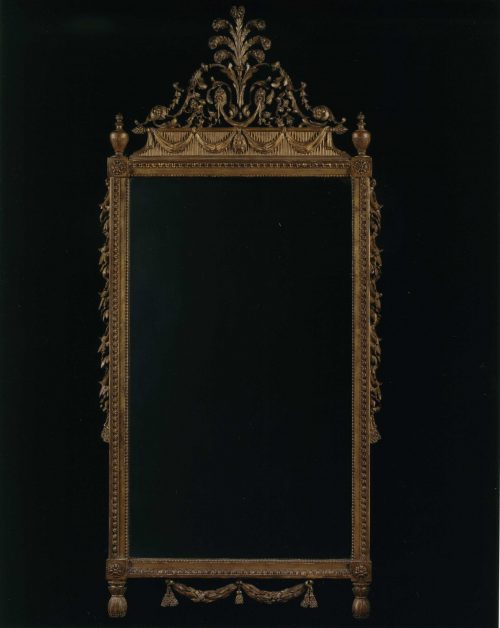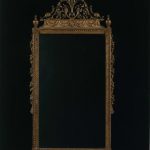9178 PAIR OF GILTWOOD NEOCLASSICAL MIRRORS IN THE GUSTAVIAN TASTE Possibly Swedish. Nineteenth Century. Measurements: Height: 63″ (160.5 cm) Width: 29 1/2″ (75 cm) Depth: 2 1/4″ (5.5 cm)

Research
Of giltwood. The mirror surmounted by a feather finial above an elaborate scrolling foliate crest set on a frieze hung from a rod terminating in finials decorated with drapery and centered by a foliate roundel, the frieze flanked by urns en flambeau with leaf pattern decoration, the mirror plate set in a frame edged with bead and repeating stylized foliate pattern moldings with foliate paterae to the corners, the frame centered below with swags and tassels flanked by tassels.
The expression of Neoclassical design in Sweden was influenced by Gustav III’s admiration for life at the French court of Versailles, and resulted in elegant, delicate interpretations of decorative art objects. “Rooms were embellished with long, giltwood framed mirrors, crystal chandeliers, gilt torchères and Classical-style vases and urns of Swedish porphyry.”1
Gustav, who had traveled to Paris in 1771 and Italy in 1783, encouraged craftsmen to train abroad in these countries before returning to Stockholm to create the king’s neoclassical vision. Motifs derived from the mid-18th century discovery and dissemination of archaeological findings at Pompeii and Herculaneum continued to inspire late Gustavian design, which was rectilinear and symmetrical, “with classical details such as beadings, rosettes and garlands.”2
The present pair of mirrors is an example of the late Gustavian period of style which carried over into the 19th century, prior to the spread of the Empire style by Napoleon. and is related to the work of late 18th century craftsmen like Per Westin and Johan Åkerbald. The classical motifs used in its design includes lotus leaf molding, swags of laurel, flaming urns, paterae, and pine cone finials. Pier glasses were widely popular at this time, as were trompe l’oeil wall paintings of classical borders, and corded and tasseled drapery became extremely fashionable toward the turn of the century,3 elements of which are also reflected in the design of the present mirrors.
Footnotes:
1. The Grove Dictionary of Art: From renaissance to impressionism
2. A Swedish Legacy 36

Comments are closed.